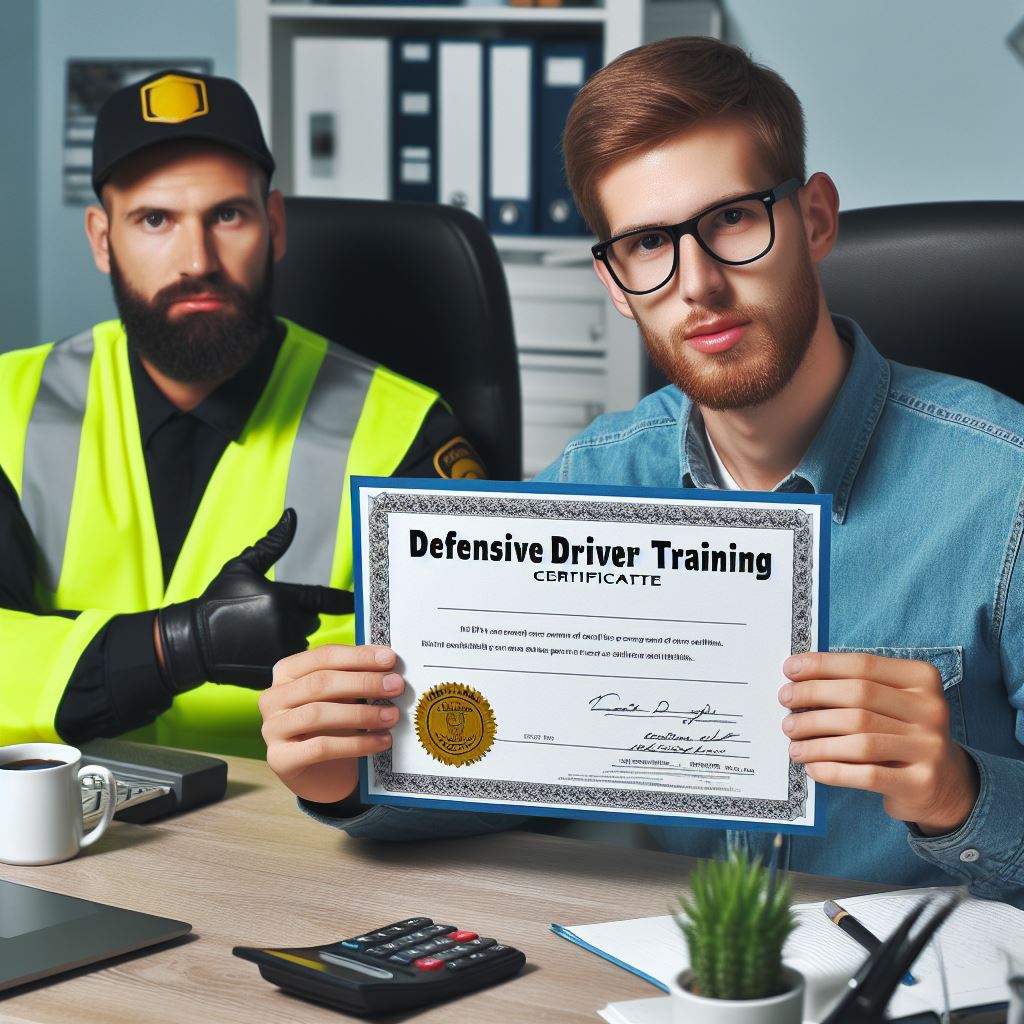
Soaring gas prices and car repairs make cheaper car insurance an enticing prospect. Defensive driving training often gets touted as a way to slash those premiums, but does it hold water? Follow along, as CheapInsurance.com navigates the winding road of car insurance discounts and answer all your burning questions about defensive driving.
Can you Steer Down Your Car Insurance Costs with Defensive Driving?
The answer, thankfully, is a resounding yes! Insurance companies view drivers who complete defensive driving courses as being safer and more responsible behind the wheel. This lower risk translates to reduced premiums for them, and potential savings for you. Studies by the Insurance Institute for Highway Safety (IIHS) show that completing a defensive driving course can lead to a 5-15% discount on your car insurance, with some states offering even greater reductions.
Key Takeaways:
- Defensive driving training can significantly reduce your car insurance, typically by 5-15%, with some states offering even more.
- Beyond savings, the course equips you with valuable skills in accident avoidance, traffic law awareness, and safer driving habits.
- It benefits all drivers, from newbies building a foundation to experienced drivers sharpening their skills and mitigating past violations.
- Choosing the right course is key! Consider recommendations from your insurance provider, state requirements, and flexibility options.
- Invest in your safety and wallet. Complete the course, keep a clean record, and compare insurance rates to maximize your savings.
How Much Cash Can You Cruise On? The Varying Discounts of Defensive Driving Courses
Imagine cruising down the highway, not just enjoying the wind in your hair, but the sweet symphony of savings jingling in your pocket. That’s the melody defensive driving courses play for your car insurance costs! Discounts vary like the terrain on a road trip, influenced by your insurance provider, your location, and even your age. But here’s a map to navigate the potential gold mines:
The Steady Breeze of Savings: In most cases, defensive driving courses can propel you towards a 5-15% reduction in your overall premium. That’s like finding a crisp twenty tucked under your car seat every month!
High-Gear Discounts for Specific Drivers: Buckle up, young drivers and senior road-warriors! Your age can unlock turbo-charged savings, with discounts reaching up to 20% for teenagers and seniors in some cases. Just keep your eyes peeled for these age-specific offers while charting your course.
State-by-State Variations: Discounts can be as diverse as the landscape itself. In California, you might find a steady 5% breeze, while Massachusetts can offer gusts of up to 25% savings. So, check your local forecast before signing up to ensure you’re cruising towards the most lucrative discounts.
Remember, these are just general guidelines. To truly map your route to maximum savings, consult your insurance provider and explore courses approved in your state. With the right approach, you could be cruising towards significantly lower car insurance costs, leaving more cash in your pocket for the real joyride – hitting the open road!
Beyond the Brakes: What Skills Earn You Savings?
Unpacking the Benefits of Defensive Driving
Imagine steering your car onto a winding coastal road, the salty breeze whipping through your hair. But instead of admiring the stunning scenery, you’re fixated on the map, squinting at the twists and turns, eager to reach your destination – cheaper car insurance. That’s exactly what completing a defensive driving course feels like! It’s your roadmap to navigating the maze of discounts, slashing those pesky premiums and leaving you with more cash to enjoy the real ride.
Now, the discount landscape for defensive driving courses can be as diverse as the terrain on a cross-country trip. It varies like the ocean tides, influenced by your insurance provider, your location, and even your age. But fret not, intrepid adventurer! Let’s unpack the secret stashes of savings:
The Steady Trade Winds of Savings: In most cases, completing a defensive driving course is like catching a steady trade wind, propelling you towards a 5-15% reduction in your overall premium. It’s like finding a crisp $20 tucked under your car seat every month – a pleasant surprise that keeps your budget smiling.
Turbocharged Discounts for Specific Drivers: Buckle up, young drivers and senior road warriors! Your age can unlock hidden turbo-charged discounts in this financial treasure hunt. Teenagers and seniors can score up to 20% off in some cases, like finding a secret fuel injector that makes your insurance costs plummet. Keep your eyes peeled for these age-specific windfalls!
State-by-State Variations: The terrain of discounts can be as diverse as the Grand Canyon itself. In California, you might find a steady 5% breeze, while Massachusetts can offer gusts of up to 25% savings. So, before embarking on your journey, consult your local weather forecast (aka, your insurance provider) to ensure you’re charting the course towards the most lucrative discounts.
Remember, these are just the compass points on your adventure map. To truly discover the hidden oases of savings, consult your specific insurance provider and explore courses approved in your state. With the right navigation, you could be cruising towards significantly lower car insurance costs, leaving you with more cash to fill your trunk with unforgettable experiences on the open road!
So, ditch the stress of soaring insurance costs and grab the wheel of defensive driving training. It’s the perfect road trip to financial freedom, filled with scenic discounts and the ultimate destination – peace of mind on every journey.

Beyond the Brakes: Unlocking the Vault of Safer Skills and Lower Premiums
The Ninja Moves of Accident Avoidance: Forget dodging arrows; in this course, you’ll master the art of evading hazards! Learn to spot potential dangers like a hawk, maneuver your vehicle like a stealthy ninja, and position yourself defensively to avoid collisions before they even begin. Every scrape prevented is a gold coin saved on your insurance!
The Compass of Traffic Law Awareness: Feeling lost in the jungle of traffic regulations? This course acts as your trusty compass, brushing up your knowledge of road rules and safety regulations. From stop signs to lane changes, you’ll navigate the traffic landscape with confidence, minimizing those pesky tickets that can jack up your premiums. Remember, a compliant driver is a rewarded driver!
The Shield of Defensive Mindset: This course isn’t just about mastering maneuvers; it’s about rewiring your driving mindset. You’ll learn to anticipate risks, plan ahead, and stay constantly aware of your surroundings. It’s like building an invisible shield around your car, one that deflects bad decisions and reduces your overall risk profile. Insurance companies love seeing defensive drivers – because accidents love seeing the opposite!
But the hidden treasure doesn’t end there. Defensive driving also polishes your skills in:
Communication: Learn to communicate effectively with other drivers, avoiding misunderstandings and potential incidents.
Here are some ways a defensive driving course can help drivers learn to communicate more effectively:

Verbal Communication:
Signal Clarity: The course emphasizes the importance of using turn signals early and consistently, conveying your intentions clearly to other drivers.
Honk Etiquette: Learn how and when to use your horn appropriately, avoiding aggressive honking that can escalate situations.
Verbal De-escalation: Techniques for calmly communicating with upset or frustrated drivers, minimizing the risk of road rage incidents.
Non-Verbal Communication:
Headlight Signals: Understanding how to use headlights to communicate, like flashing to warn of hazards or to acknowledge thanks.
Proper Lane Positioning: Maintaining a safe and consistent lane position avoids confusion and potential conflict with other drivers.
Hand Gestures: Using hand signals appropriately for turning, stopping, or expressing gratitude, especially in situations where verbal communication might be difficult.
Anticipatory Communication:
Reading the Flow of Traffic: Understanding how other drivers are likely to behave and adjusting your actions accordingly.
Recognizing Road Rage Triggers: Identifying aggressive or erratic driving behavior early on and taking measures to avoid becoming involved.
Maintaining a Calm Demeanor: Projecting a calm and respectful presence through body language and facial expressions can de-escalate potential conflicts.
By training in these communication skills, drivers can:
- Reduce misunderstandings and misinterpretations that often lead to accidents.
- Foster a more courteous and cooperative driving environment for everyone.
- Avoid unnecessary confrontations and potentially dangerous situations.
Remember, effective communication on the road goes beyond just words. It’s about using all available channels – verbal, non-verbal, and anticipatory – to convey your intentions clearly and avoid misunderstandings.
Defensive driving courses equip drivers with the tools and techniques to do just that, making them safer, more courteous, and ultimately, more responsible road users.
Distraction Control: Master the art of staying focused on the road, leaving your phone in the glove compartment – and your insurance company smiling.
Here are some ways defensive driving courses help drivers master the art of distraction control and keep their eyes on the prize (the road, not their phone!):
Understanding the Dangers:
- The course quantifies the risks: By outlining the dangers of distracted driving and the devastating consequences of even a momentary lapse in attention, they instill a sense of responsibility and urgency in staying focused.
- Different types of distractions: Explore various distractions ranging from phones and food to loud music and conversations, making drivers aware of potential pitfalls.
Building Awareness and Habits:
- Mindfulness exercises: Techniques like mindful breathing and active scanning of the environment help drivers maintain situational awareness and identify potential distractions before they take hold.
- Phone management strategies: Encourage leaving phones in the glove compartment or activating “Do Not Disturb” mode while driving, creating a distraction-free zone in the car.
- Planning ahead: Strategize for potential distractions like adjusting music, sending messages, or setting navigation before starting the journey, avoiding fiddling with devices while driving.
Developing Coping Mechanisms:
- The “Two-Second Rule”: Practicing maintaining a safe distance based on reaction time, allowing for focus on the road even if briefly distracted.
- Scanning techniques: Train drivers to quickly scan mirrors and surroundings without taking their eyes off the road for extended periods, minimizing the impact of momentary distractions.
- Visual cues: Encourage utilizing landmarks, signs, and road markings to stay on course without relying on constant GPS navigation, reducing reliance on technology.
Encouraging Accountability:
- Group discussions and role-playing: Sharing experiences and practicing scenarios in a safe environment help drivers understand the real-world implications of distracted driving and hold each other accountable.
- Simulations and virtual reality: Utilizing technology to experience the dangers of distracted driving firsthand can create a lasting impact and reinforce safe habits.
- Post-course follow-up: Resources and reminders help drivers maintain their focus and continue practicing distraction-free driving long after completing the course.
By understanding the risks, creating awareness, building coping mechanisms, and fostering accountability, defensive driving courses empower drivers to combat distractions and stay laser-focused on the road. This not only protects their own safety but also contributes to a safer environment for everyone sharing the streets. Remember, a moment of distraction can have lasting consequences. Defensive driving courses equip drivers with the tools and knowledge to make sure that moment never comes.
Emergency preparedness: Be ready for anything, from flat tires to sudden stops, with skills that keep you calm and in control even when things get bumpy.
Defensive driving courses don’t just teach you how to avoid accidents; they also equip you with the skills and knowledge to handle emergencies when they occur. Here’s how they prepare drivers for the unexpected:
Building a Preparedness Mindset:
- Risk Assessment: The course emphasizes the importance of anticipating potential hazards and proactively preparing for them. Drivers learn to scan the environment for potential risks like weather conditions, road defects, or erratic driver behavior.
- Emergency Kit Essentials: Understanding the importance and proper use of an emergency kit, including essentials like a first-aid kit, flares, jumper cables, and a fire extinguisher.
- Calm Under Pressure: Techniques for maintaining composure and staying focused in an emergency situation, avoiding panic-driven actions that can exacerbate the situation.
Developing Practical Skills:
- Vehicle Maintenance Basics: Learn to perform basic car checks like tire pressure, fluid levels, and light functionality, ensuring your vehicle is in optimal condition to handle an emergency.
- Safe Braking and Maneuvers: Practice emergency braking techniques, evasive maneuvers like swerving or skid control, and safe stopping procedures like downshifting or using the parking brake in different scenarios.
- Post-Accident Protocol: The course outlines essential steps following an accident, including securing the scene, checking for injuries, contacting emergency services, and documenting the incident.
Enhancing Confidence and Resourcefulness:
- Role-Playing Exercises: Simulating emergency situations like flat tires, engine trouble, or encountering aggressive drivers allows drivers to practice their skills and build confidence in handling real-world scenarios.
- Hazard Recognition and Response: Learn to identify different types of road hazards, from wildlife crossings to slippery surfaces, and implement appropriate avoidance or defensive driving strategies.
- Problem-Solving Techniques: Encourages critical thinking and resourcefulness in unexpected situations, empowering drivers to adapt and overcome challenges on the road.
By building a preparedness mindset, developing practical skills, and enhancing confidence, defensive driving courses equip drivers with the tools and knowledge to navigate emergencies calmly and effectively. This not only increases their own safety but also helps minimize potential harm to others. Remember, being ready for the unexpected can turn a potentially disastrous situation into a manageable one. Defensive driving courses ensure you’re in the driver’s seat when it comes to your own safety and well-being on the road.
Remember, every skill you hone, every hazard you anticipate, and every safe decision you make is another nugget of gold added to your savings chest. So, enroll in a defensive driving course, unlock the vault of safer skills, and watch your car insurance costs take a delightful nosedive. It’s an investment that pays off for both your wallet and your peace of mind, making every ride a treasure hunt for safer roads and lower premiums.

Are You Eligible for the Green Light? Factors Affecting Discount Eligibility
Not everyone automatically qualifies for a defensive driving discount. Here are some key factors to keep in mind:
- Course Type: Only approved courses by your insurance company and state will count. Check with your provider for specifics.
- Driving History: Recent traffic violations or accidents might make you ineligible, but completing the course can sometimes help mitigate the impact.
- Eligibility Period: Discounts usually last for 2-3 years after completing the course.
Beyond the Discount: The Long-Term Rewards of Safer Roads (The intangible benefits)
While car insurance savings are enticing, the benefits of defensive driving extend far beyond your wallet:
- Reduced Accident Risk: The training empowers you to make safer choices on the road, potentially preventing accidents and safeguarding yourself and others.
- Increased Confidence: Mastering new skills and understanding traffic dynamics boosts your confidence behind the wheel, making driving less stressful.
- Improved Driving Habits: The course fosters a more cautious and observant driving style, benefiting everyone on the road.
Foot on the Gas? Navigating the Maze of Defensive Driving Courses
With a plethora of defensive driving courses available, choosing the right one can be overwhelming. Here are some pointers:
- Insurance Provider Recommendation: Ask your insurance company for approved courses they offer discounts for.
- Course Format: Select a format that suits you, like online, classroom, or blended learning.
- State Approval: Ensure the course is approved by your state’s Department of Motor Vehicles (DMV).
- Review Ratings and Feedback: Read student reviews and compare offerings before enrolling.
Top Tips for Maximizing Your Discount
Once you’ve chosen a course, follow these tips to maximize your discount:
- Enroll Before Renewal: Time your completion near your policy renewal date to get the full discount period.
- Maintain a Clean Driving Record: Avoid traffic violations after completing the course to secure continued savings.
- Shop Around for Better Rates: Armed with your defensive driving certificate, you can leverage your improved driving profile to potentially negotiate lower premiums with other insurance companies.

Hitting the Brakes on Myths: Debunking Common Misconceptions about Defensive Driving Discounts
Myth #1: “Defensive driving courses only lower rates after a ticket.”
While completing a course after a ticket might help mitigate its impact, you can generally qualify for discounts even with a clean driving record.
Myth #2: “The discounts aren’t worth the cost of the course.”
Most courses are affordable, typically ranging from $25 to $100. Considering the potential for significant savings on your car insurance over several years, the return on investment often outweighs the upfront cost.
Myth #3: “Defensive driving courses are just for bad drivers.”
This misconception couldn’t be further from the truth! While drivers with recent violations might benefit from the course to improve their record, defensive driving skills are valuable for everyone.
Think of it like this: even the most skilled athlete can benefit from additional training. Similarly, even the safest driver can learn new techniques to stay ahead of potential hazards and navigate complex traffic situations confidently.
Whether you’re a seasoned driver seeking to refine your skills or a new driver building a strong foundation, defensive driving provides valuable knowledge and practical tools that benefit everyone on the road.
Myth #4: “Taking the course online doesn’t count.”
While classroom courses offer the benefit of in-person interaction, many online courses are equally effective and approved by insurance companies and state DMVs. The key is to ensure the course meets your state’s requirements and is offered by a reputable provider.
Online courses provide flexibility and convenience, allowing you to complete the training at your own pace and from the comfort of your own home. This accessibility makes defensive driving even more attainable for a wider range of individuals.
Myth #5: “I already know everything I need to know about safe driving.”
No matter how experienced you are, there’s always room for improvement and learning new things. Traffic laws and driving dynamics evolve over time, and defensive driving courses stay updated with the latest best practices and insights.
Refresher courses, even for experienced drivers, can sharpen awareness, reinforce safe habits, and introduce new techniques or scenarios you might not have encountered before. This proactive approach can further reduce your risk and keep you and others safe on the road.
By debunking these common myths, we hope to shed light on the true value of defensive driving training. It’s not just about getting the cheapest car insurance; it’s about becoming a safer, more responsible, and more confident driver, contributing to a safer driving environment for everyone.
Remember, the knowledge and skills you gain from a defensive driving course are an investment in your own safety and the safety of others. It’s a win-win situation, benefiting both your wallet and the peace of mind that comes from knowing you’re equipped to handle any situation on the road.
So, the next time you find yourself questioning the value of defensive driving training, remember this: hit the brakes on misconceptions and steer towards a safer and more rewarding driving experience.
Is Defensive Driving the Right Road for You? Weighing the Benefits and Costs
Whether defensive driving is the right road for you depends on a personal cost-benefit analysis. Let’s weigh the factors:
Reasons You Might Benefit:
- Saving Money on Car Insurance: The potential discounts are a clear advantage, especially if you drive regularly or have a higher-risk profile.
- Improving Your Driving Skills: Regardless of your experience, new techniques and a refreshed understanding of traffic laws can boost your confidence and safety.
- Reducing Accident Risk: Learning defensive maneuvers and risk assessment can significantly lower your chances of being involved in a collision.
- Contributing to Safer Roads: By becoming a more responsible and proactive driver, you contribute to a safer environment for everyone on the road.
- Personal Growth and Satisfaction: Mastering new skills and taking control of your driving can be a rewarding experience, boosting your confidence and peace of mind.
Factors to Consider:
- Cost of the Course: While generally affordable, the upfront cost might be a deterrent for some.
- Time Commitment: Completing the course requires dedicating time and effort, which might not be feasible for everyone’s schedule.
- Driving Frequency: If you drive infrequently, the potential savings might not outweigh the cost or time investment.
- Driving Record: If you have a clean driving record, the discount might not be as significant as for someone with a higher-risk profile.
Ultimately, the decision is personal. Weigh the potential benefits against the costs and consider your individual circumstances and driving needs. If the advantages resonate with you, then defensive driving can be a worthwhile investment in your safety, your wallet, and the well-being of everyone on the road.
Fast Forward to Savings: Resources and Next Steps for Lowering Your Car Insurance
Now that you’re equipped with the knowledge to make an informed decision, let’s fast-forward to the practical steps for securing your discount:
- Check your eligibility: Contact your insurance provider to confirm if they offer discounts for defensive driving courses and what specific courses are approved.
- Choose a course: Research and select a course that meets your needs and schedule, considering factors like format, price, and instructor qualifications.
- Enroll and complete the course: Dedicate yourself to learning the material and practicing the skills taught.
- Obtain completion certificate: Upon finishing the course, receive your official certificate to prove your accomplishment.
- Update your insurance information: Contact your insurance provider and provide your certificate to claim your discount.
- Shop around (optional): Armed with your defensive driving certificate and improved driving profile, you can explore other insurance companies to see if you can secure even lower rates.
Bonus Resources:
- National Defensive Driving Association: https://www.nsc.org/safety-training/defensive-driving
- The National Highway Traffic Safety Administration (NHTSA): https://www.nhtsa.gov/
- Your State’s Department of Motor Vehicles (DMV): Find your state’s DMV website to access information about approved defensive driving courses.
Remember, taking control of your driving safety and lowering your car insurance costs are within reach. By investing in defensive driving training, you can reap the rewards of safer roads, greater confidence, and potentially significant financial savings.


